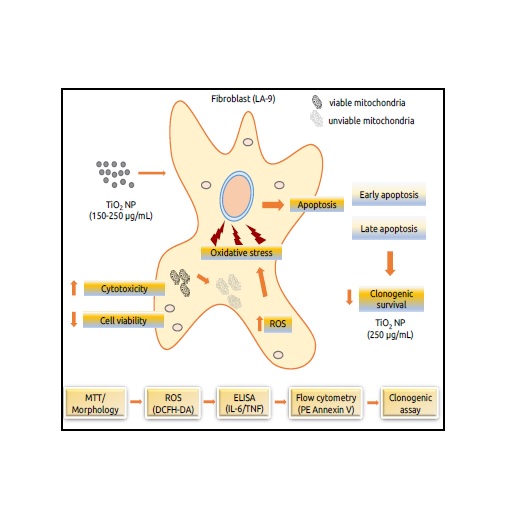Titanium dioxide nanoparticle (TiO2 NP) induces toxic effects on LA-9 mouse fibroblast cell line.
FATTORI, Ana Carolina Maragno; BRASSOLATTI, Patrícia; FEITOSA, Karina Alves; GONÇALVES, Matheus Pedrino; CORREIA, Ricardo de Oliveira; ALBUQUERQUE, Yulli Roxenne; RODOLPHO, Joice Margareth de Almeida; LUNA, Genoveva Lourdes Flores; BERNARDI, Juliana Cancino; ZUCOLOTTO, Valtencir; SPEGLICH, Carlos; ROSSI, Karina Nogueira Zambone Pinto; ANÍBAL, Fernanda de Freitas.
FATTORI, Ana Carolina Maragno; BRASSOLATTI, Patrícia; FEITOSA, Karina Alves; GONÇALVES, Matheus Pedrino; CORREIA, Ricardo de Oliveira; ALBUQUERQUE, Yulli Roxenne; RODOLPHO, Joice Margareth de Almeida; LUNA, Genoveva Lourdes Flores; BERNARDI, Juliana Cancino; ZUCOLOTTO, Valtencir; SPEGLICH, Carlos; ROSSI, Karina Nogueira Zambone Pinto; ANÍBAL, Fernanda de Freitas.





 Abstract: Background/aims: Titanium dioxide nanoparticles (TiO2 NPs) are extensively applied in the industry due to their photocatalytic potential, low cost, and considerably low toxicity. However, new unrelated physicochemical properties and the wide use of nanoparticles brought concern about their toxic effects. Thereby, we evaluated the cytotoxicity of a TiO2 NP composed of anatase and functionalized with sodium carboxylate ligands in a murine fibroblast cell line (LA-9). Methods: Scanning Electron Microscopy (SEM), Dynamic Light Scattering (DLS), and ATR-FTIR spectroscopy were applied to determine nanoparticle physicochemical properties. The cell viability (MTT assay) and clonogenic survival were analyzed in fibroblasts exposed to TiO2 NP (50, 150, and 250 µg/mL) after 24h. Moreover, oxidative stress, proinflammatory state, and apoptosis were evaluated after 24h. Results: TiO2 NP characterization showed an increased hydrodynamic size (3.57 to 7.62 nm) due to solvent composition and a heterogeneity dispersion in water and cell culture media. Also, we observed a zeta potential increased from -20 to -11 mV in function of protein adsorption. TiO2 NP reduced fibroblast cell viability and induced ROS production at the highest concentrations (150 and 250 µg/mL). Moreover, TiO2 NP reduced the fibroblasts clonogenic survival at the highest concentration (250 µg/mL) on the 7th day after the 24h exposure. Nevertheless, TiO2 NP did not affect the fibroblast proinflammatory cytokines (IL-6 and TNF) secretion at any condition. Early and late apoptotic fibroblast cells were detected only at 150 µg/mL TiO2 NP after 24h. Conclusion: Probably, TiO2 NP photocatalytic activity unbalanced ROS production which induced apoptosis and consequently reduced cell viability and metabolic activity at higher concentrations.
Abstract: Background/aims: Titanium dioxide nanoparticles (TiO2 NPs) are extensively applied in the industry due to their photocatalytic potential, low cost, and considerably low toxicity. However, new unrelated physicochemical properties and the wide use of nanoparticles brought concern about their toxic effects. Thereby, we evaluated the cytotoxicity of a TiO2 NP composed of anatase and functionalized with sodium carboxylate ligands in a murine fibroblast cell line (LA-9). Methods: Scanning Electron Microscopy (SEM), Dynamic Light Scattering (DLS), and ATR-FTIR spectroscopy were applied to determine nanoparticle physicochemical properties. The cell viability (MTT assay) and clonogenic survival were analyzed in fibroblasts exposed to TiO2 NP (50, 150, and 250 µg/mL) after 24h. Moreover, oxidative stress, proinflammatory state, and apoptosis were evaluated after 24h. Results: TiO2 NP characterization showed an increased hydrodynamic size (3.57 to 7.62 nm) due to solvent composition and a heterogeneity dispersion in water and cell culture media. Also, we observed a zeta potential increased from -20 to -11 mV in function of protein adsorption. TiO2 NP reduced fibroblast cell viability and induced ROS production at the highest concentrations (150 and 250 µg/mL). Moreover, TiO2 NP reduced the fibroblasts clonogenic survival at the highest concentration (250 µg/mL) on the 7th day after the 24h exposure. Nevertheless, TiO2 NP did not affect the fibroblast proinflammatory cytokines (IL-6 and TNF) secretion at any condition. Early and late apoptotic fibroblast cells were detected only at 150 µg/mL TiO2 NP after 24h. Conclusion: Probably, TiO2 NP photocatalytic activity unbalanced ROS production which induced apoptosis and consequently reduced cell viability and metabolic activity at higher concentrations. @article={003127088,author = {FATTORI, Ana Carolina Maragno; BRASSOLATTI, Patrícia; FEITOSA, Karina Alves; GONÇALVES, Matheus Pedrino; CORREIA, Ricardo de Oliveira; ALBUQUERQUE, Yulli Roxenne; RODOLPHO, Joice Margareth de Almeida; LUNA, Genoveva Lourdes Flores; BERNARDI, Juliana Cancino; ZUCOLOTTO, Valtencir; SPEGLICH, Carlos; ROSSI, Karina Nogueira Zambone Pinto; ANÍBAL, Fernanda de Freitas.},title={Titanium dioxide nanoparticle (TiO2 NP) induces toxic effects on LA-9 mouse fibroblast cell line},journal={Cellular Physiology and Biochemistry},note={v. 57, n. 2, p. 63-81},year={2023}}
@article={003127088,author = {FATTORI, Ana Carolina Maragno; BRASSOLATTI, Patrícia; FEITOSA, Karina Alves; GONÇALVES, Matheus Pedrino; CORREIA, Ricardo de Oliveira; ALBUQUERQUE, Yulli Roxenne; RODOLPHO, Joice Margareth de Almeida; LUNA, Genoveva Lourdes Flores; BERNARDI, Juliana Cancino; ZUCOLOTTO, Valtencir; SPEGLICH, Carlos; ROSSI, Karina Nogueira Zambone Pinto; ANÍBAL, Fernanda de Freitas.},title={Titanium dioxide nanoparticle (TiO2 NP) induces toxic effects on LA-9 mouse fibroblast cell line},journal={Cellular Physiology and Biochemistry},note={v. 57, n. 2, p. 63-81},year={2023}}